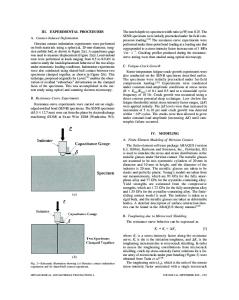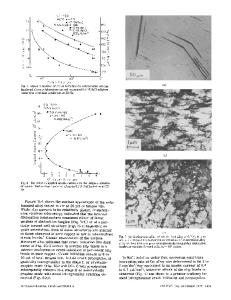An investigation of the fatigue and fracture behavior of a Nb-12Al-44Ti-1.5Mo intermetallic alloy
- PDF / 3,304,220 Bytes
- 14 Pages / 612 x 792 pts (letter) Page_size
- 8 Downloads / 329 Views
INTRODUCTION
THE ongoing interest in the development of intermediate-temperature structural materials has stimulated considerable research on the use of niobium aluminide–based intermetallics for possible applications in the intermediatetemperature regime around 750 8C.[1–11] The interest in niobium aluminide–based intermetallics has been largely due to their attractive combinations of ductility and damage tolerance.[1–6] The oxidation resistance of niobium aluminide– based intermetallics has also been shown to be adequate for 750 8C aeroengine applications.[9] Their potential service temperature limit (of approximately 750 8C) is, therefore, below that of the niobium silicide[12,13,14] and the Laves phase[15,16] intermetallics that are being developed for potential high-temperature structural applications in the temperature regime above 1000 8C. Nevertheless, with their moderate densities of ,6.1 g/cm3,[6] niobium aluminides represent one of the promising alloy systems that have emerged from extensive alloy development efforts in recent years.[6,8,11] These efforts have shown that the addition of ,40 at. pct Ti to the A15 Nb15Al (Nb3Al) base promotes the stabilization of the B2 phase.[6] The stabilization of the B2 phase in the Nb-15Al40Ti alloy was also shown to result in improved ductility (,10 to 30 pct) and fracture toughness (40 to 110 MPa!m).[4] Alloying with Mo, and a slight adjustment of the Al and Ti contents of the Nb-15Al-40Ti base, was also W.O. SOBOYEJO, Associate Professor, J. DIPASQUALE, Graduate Student, and F. YE and C. MERCER, Postdoctoral Research Associates, are with the Department of Materials Science and Engineering, The Ohio State University, Columbus, OH 43210-1179. T.S. SRIVATSAN, Professor, is with the Department of Mechanical Engineering, the University of Akron, Akron, OH 44325-0002. D.G. KONITZER, Lead Engineer, is with General Electric Aircraft Engines, Cincinnati, OH 45215-1915. Manuscript submitted May 7, 1998. METALLURGICAL AND MATERIALS TRANSACTIONS A
found to result in improved creep resistance and damage tolerance.[8] The alloy development efforts in Reference 8 resulted in an “optimal” B2 1 orthorhombic alloy with a nominal composition of Nb-12Al-44Ti-1.5Mo. This article presents the results of a study of the fatigue and fracture behavior of the Nb-12Al-44Ti-1.5Mo alloy (44Ti alloy). Following a brief description of material processing and microstructural features in Section II, the experimental details are presented in Section III. The micromechanisms of fracture and fatigue in smooth and notched specimens are then elucidated in Section IV, along with the associated mechanical property data. The implications of the results are examined in Section V, in which the fatigue and fracture properties of the 44Ti alloy are also compared to those of existing and emerging high-temperature structural alloys. Finally, salient conclusions arising from this work are summarized in Section VI.
II. MATERIAL The 44Ti alloy that was used in this experimental study was supplied by Teledyne Wah
Data Loading...











